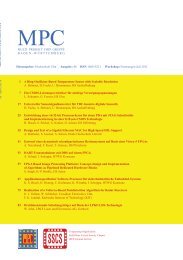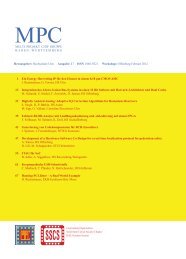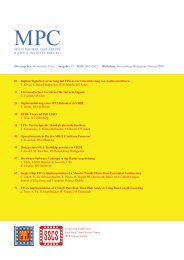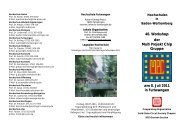Workshopband als PDF - Mpc.belwue.de
Workshopband als PDF - Mpc.belwue.de
Workshopband als PDF - Mpc.belwue.de
Erfolgreiche ePaper selbst erstellen
Machen Sie aus Ihren PDF Publikationen ein blätterbares Flipbook mit unserer einzigartigen Google optimierten e-Paper Software.
Figure 4: Block diagram of CAN Controller connected to the Android<br />
<strong>de</strong>vice using IOIO.<br />
project name is "android-serialport-api“ [17]. The<br />
serial ports on the Tsunami board can be used with<br />
this api. Moreover, the Modbus [18] protocol can be<br />
used. The application level protocol operates directly<br />
on top of a serial interface and serial communication<br />
standards [19].<br />
3) GPIO, SPI and CAN<br />
The support for other peripher<strong>als</strong> is present on the<br />
Tsunami board. However, no out of the box solutions<br />
or precompiled libraries exist for them. The IOIO<br />
board was used to provi<strong>de</strong> the other peripher<strong>als</strong> required<br />
for the system.<br />
B. Using IOIO Board<br />
1) GPIO<br />
All 48 pins on the IOIO board can be configured and<br />
used as GPIO’s. For this both digital and analogue<br />
input/output tests were performed. For the digital<br />
output an LED was successfully controlled with the<br />
IOIO board. Using the IOIO board implementing the<br />
GPIO functionality is quite straight forward.<br />
2) SPI<br />
There is a special class in the IOIO library called<br />
"SpiMaster.java". Controlling the IOIO SPI interface<br />
is done via the SpiMaster class. An instance of this<br />
interface corresponds to a single SPI module on the<br />
board, as well as to the pins it uses for CLK, MOSI,<br />
MISO and SS (one or more) [20].<br />
In the test setup it was tested to make the SPI work<br />
in the Master mo<strong>de</strong> using a fixed buffer of 0x55 and it<br />
transmitted successfully. During the tests the transmitted<br />
signal was good up to 1 Mbps but it started distorting<br />
after that and it worked till 3.2 Mbps. At higher<br />
speeds, the output signal <strong>de</strong>gra<strong>de</strong>d significantly.<br />
70<br />
Figure 5: OpenXC architecture [22].<br />
3) CANbus<br />
CAN Bus [21] is <strong>als</strong>o not natively supported on Android.<br />
One possible solution is to use the SPI of IOIO<br />
board to control a CAN controller from the Android<br />
<strong>de</strong>vice. Such a CAN controller is provi<strong>de</strong>d by Microchip,<br />
MCP2515 [23]. Figure 4 shows the block diagram<br />
of the proposed solution.<br />
Another interesting solution is the OpenXC architecture<br />
[22] <strong>de</strong>veloped by Ford and Bug labs. It connects<br />
the CAN bus to the Android <strong>de</strong>vice over USB using a<br />
CAN translator in between. Figure 5 shows the overall<br />
architecture. The Android libraries of the project are<br />
available on the projects webpage.<br />
4) UART<br />
HEADLESS ANDROID SYSTEMS FOR<br />
INDUSTRIAL AUTOMATION AND CONTROL<br />
The IOIO Board <strong>als</strong>o offers a UART interface,<br />
which can be used in a similar way as the Tsunami<br />
boards UART.<br />
VII. IOIO TIMING TESTS<br />
The purpose of the tests was to test the round trip<br />
time of communication from Android to the IOIO<br />
board and back. The i<strong>de</strong>a was to measure the <strong>de</strong>lays<br />
that incurred during this communication process.<br />
These tests were performed to assess the setup's feasibility<br />
for target systems communication timing requirements,<br />
which are very strict for automation control<br />
systems. The goal was to achieve a signal cycle<br />
time of less than 12.5 ms because it sufficed the timing<br />
requirements of the target automation systems.



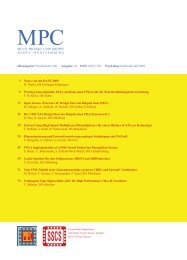
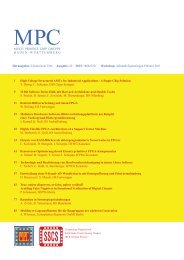
![[Geben Sie hier die Überschrift ein] - MPC](https://img.yumpu.com/8654082/1/188x260/geben-sie-hier-die-uberschrift-ein-mpc.jpg?quality=85)
